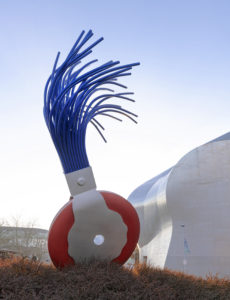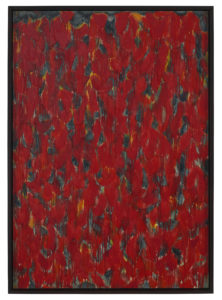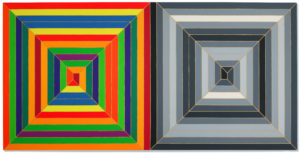
Typewriter Eraser, Scale X by Claes Oldenburg and Coosje van Bruggen
On Wednesday, November 10th, Christie’s New York continued in their sale of the Paul Allen Collection. Following the immense, billion-dollar sale the night before, the day on sale the following morning might’ve seemed a little measly. Still, it featured some incredible examples of modern and contemporary art. The works of nineteenth-century modernist masters like Cézanne and Van Gogh dominated the evening sale. While works by Toulouse-Lautrec, Sisley, and Signac were featured in the day sale, the twentieth-century abstract masters dominated on Thursday (w/p = with buyer’s premium).

Red No. 1 by Sam Francis
The sale's top lot was, interestingly, a collaboration. The stainless steel and fiberglass sculpture Typewriter Eraser, Scale X was created in 1999 by the husband-wife team of the late Claes Oldenburg, who passed away earlier this year, and Coosje van Bruggen. Allen acquired it in the year of its creation, loaning it for ten years to the Olympic Sculpture Park at the Seattle Art Museum. Christie’s specialists predicted the sculpture to be the sale's top lot, assigning a $5M to $7M estimate range, which it easily fell into. It achieved its high estimate at $7M (or $8.41M w/p). Next was the 1953 Sam Francis painting entitled Red No. 1. The study in red and gray reminds me very much of the work of Mark Rothko, both because of its composition as a color field painting and its size (64 x 45 inches). I suppose that isn’t surprising since Francis cited abstract expressionists like Rothko as his early influences. Though Red No. 1 was expected to make a couple million dollars at least, it was surprising when the hammer came down at $5.6M (or $6.87M w/p). And finally, in third place and rounding out the day sale’s highlights of postwar and contemporary art: an incredibly colorful, geometric work by Frank Stella. The painting, Cinema de Pepsi III, was executed in 1966 and made from acrylic and fluorescent paint on canvas. Allen purchased it in 2002 at Christie’s London for the low, low price of $347.65K w/p. While the title is rather confusing and carries little significance for me, the design of the work is mesmerizing. Stella’s command of color is incredibly evident here, as even though the painting is on a single canvas, it almost looks like a photograph and its negative displayed side-by-side. Cinema de Pepsi III was also expected to sell for a hefty sum of at least $3M. It eventually fell within its pre-sale estimate at $4.6M (or $5.6M w/p).

Cinema de Pepsi III by Frank Stella
Of course, the day sale had its fair share of surprises, and interestingly enough, they couldn’t be more diametrically opposed in terms of period and style. One that was featured about a third of the way into the sale was a humble piece of terracotta, broken off from the rest of the statue. The fragment mainly consists of a pair of hands, which we now know originally belonged to a statue of the Virgin Mary created around 1460 by someone close to the master Renaissance sculptor Donatello. Since it’s only a fragment and not directly connected to Donatello himself, Christie’s specialists assigned an estimate of no more than $15K. So, of course, some people were taken aback when the hammer came down at $200K (or $252K w/p), over thirteen times what was expected. Then, on the other hand, more towards the end of the sale was an incredibly large acrylic-on-canvas painting by the American abstract painter Alden Mason. Created in 1978, the painting Sweet Encounter was expected to make no more than $8K. So the final hammer price of $150K (or $189K w/p), almost nineteen times that estimate, was completely unexpected.
The Paul Allen Collection day sale was just as successful as its counterpart the night before. Out of ninety-four available lots, sixty-two (66%) sold above estimate. Twenty-three sold within, while only nine sold below. No works went unsold that day, giving Christie’s specialists an accuracy rate of 24%. Experts predicted the sale to make $87.5M at most. Given the number of lots that sold above estimate, I guess it’s no great surprise that the auction eventually made a total of $94M.
The Paul Allen Collection Part II At Christie’s NY
Typewriter Eraser, Scale X by Claes Oldenburg and Coosje van Bruggen
On Wednesday, November 10th, Christie’s New York continued in their sale of the Paul Allen Collection. Following the immense, billion-dollar sale the night before, the day on sale the following morning might’ve seemed a little measly. Still, it featured some incredible examples of modern and contemporary art. The works of nineteenth-century modernist masters like Cézanne and Van Gogh dominated the evening sale. While works by Toulouse-Lautrec, Sisley, and Signac were featured in the day sale, the twentieth-century abstract masters dominated on Thursday (w/p = with buyer’s premium).
Red No. 1 by Sam Francis
The sale's top lot was, interestingly, a collaboration. The stainless steel and fiberglass sculpture Typewriter Eraser, Scale X was created in 1999 by the husband-wife team of the late Claes Oldenburg, who passed away earlier this year, and Coosje van Bruggen. Allen acquired it in the year of its creation, loaning it for ten years to the Olympic Sculpture Park at the Seattle Art Museum. Christie’s specialists predicted the sculpture to be the sale's top lot, assigning a $5M to $7M estimate range, which it easily fell into. It achieved its high estimate at $7M (or $8.41M w/p). Next was the 1953 Sam Francis painting entitled Red No. 1. The study in red and gray reminds me very much of the work of Mark Rothko, both because of its composition as a color field painting and its size (64 x 45 inches). I suppose that isn’t surprising since Francis cited abstract expressionists like Rothko as his early influences. Though Red No. 1 was expected to make a couple million dollars at least, it was surprising when the hammer came down at $5.6M (or $6.87M w/p). And finally, in third place and rounding out the day sale’s highlights of postwar and contemporary art: an incredibly colorful, geometric work by Frank Stella. The painting, Cinema de Pepsi III, was executed in 1966 and made from acrylic and fluorescent paint on canvas. Allen purchased it in 2002 at Christie’s London for the low, low price of $347.65K w/p. While the title is rather confusing and carries little significance for me, the design of the work is mesmerizing. Stella’s command of color is incredibly evident here, as even though the painting is on a single canvas, it almost looks like a photograph and its negative displayed side-by-side. Cinema de Pepsi III was also expected to sell for a hefty sum of at least $3M. It eventually fell within its pre-sale estimate at $4.6M (or $5.6M w/p).
Cinema de Pepsi III by Frank Stella
Of course, the day sale had its fair share of surprises, and interestingly enough, they couldn’t be more diametrically opposed in terms of period and style. One that was featured about a third of the way into the sale was a humble piece of terracotta, broken off from the rest of the statue. The fragment mainly consists of a pair of hands, which we now know originally belonged to a statue of the Virgin Mary created around 1460 by someone close to the master Renaissance sculptor Donatello. Since it’s only a fragment and not directly connected to Donatello himself, Christie’s specialists assigned an estimate of no more than $15K. So, of course, some people were taken aback when the hammer came down at $200K (or $252K w/p), over thirteen times what was expected. Then, on the other hand, more towards the end of the sale was an incredibly large acrylic-on-canvas painting by the American abstract painter Alden Mason. Created in 1978, the painting Sweet Encounter was expected to make no more than $8K. So the final hammer price of $150K (or $189K w/p), almost nineteen times that estimate, was completely unexpected.
The Paul Allen Collection day sale was just as successful as its counterpart the night before. Out of ninety-four available lots, sixty-two (66%) sold above estimate. Twenty-three sold within, while only nine sold below. No works went unsold that day, giving Christie’s specialists an accuracy rate of 24%. Experts predicted the sale to make $87.5M at most. Given the number of lots that sold above estimate, I guess it’s no great surprise that the auction eventually made a total of $94M.